A Zoom gathering of transcription volunteers meets every other Tuesday at 11:00am. We discuss the process of transcribing the historic records, and share our discoveries. If you are interested in joining us, please contact Carol Smith at csmith@christchurchphila.org.
Race, Death, and Public Health in Early Philadelphia
Records of Philadelphia’s early congregations are used by researchers to better understand issues surrounding race and public health in early America. Historian Jubilee Marshall wrote “Race, Death, and Public Health in Early Philadelphia, 1750-1793,” which was published in the Spring 2020 edition of Pennsylvania History: A Journal of Mid-Atlantic Studies. Her paper draws upon many of the sources that are available on our website.
From the article’s abstract: “The recent discovery of burial sites associated with Philadelphia’s early black community has raised questions about their historical context. This article situates Philadelphia’s African American burials against the backdrop of public health in the 1700s. Public health concerns were omnipresent in Philadelphia as it developed and expanded, and its inhabitants sought to navigate the complex challenges that accompanied such growth. For the black residents of Philadelphia, contending with these public health challenges was especially difficult given the added burden of their disempowerment in the institutional structure of the city. Thus, before the emergence of African American churches and their accompanying cemeteries in the 1790s, white burial grounds, including churchyards and public lots, functioned as an arena of racial contestation, where members of the black community sought to exercise power within the city. The Free African Society and Yellow Fever epidemic of the 1790s are also considered.”
The article is free to many University users; $19 to purchase for individual researchers. You might also be able to talk the author into providing a complementary copy for a good cause. Visit Jubilee Marshall’s website.
Black Burials in Philadelphia: An Audio Walking Tour
From our friend Jubilee Marshall, a fascinating glimpse into the history of black burials in Philadelphia, via an audio walking tour.
“Philadelphia is a city of graveyards. A simple google search will reveal dozens, if not hundreds, of incidents of construction workers and developers breaking soil only to discover that what they thought was untouched ground was actually a resting place for Philadelphians of days past.
“Frequently, these resting places are specifically connected to the history of the Black community in Philadelphia — a sharp contrast to the many white churchyards and burial places that constitute a huge part of tourism in today’s Old City.
“What is the history of these burial grounds? Why are they important? And how did so many come to be hidden around the city, under public parks and parking lots? Take this self-guided walking tour to find out.”
Early Swedish Settlers’ relations with the Delaware Indians
This manuscript contains many accounts of Swedish settlement along the Delaware River from the early 17th century to the mid-late 18th century, including the relations of Swedish settlers with the Delaware Indians, from whom they bought land and with whom they traded. The following are selections from the text.
The Case of the Missing Document
It can sometimes be instructive to compare early translations with later ones, as with an account of the lands granted to early Swedish settlers by the Delaware Indians. The original Swedish text appears in images 3 and 4. Reverend Andrew Rudman, “founder and first Rector of the present Church at Wicacoa, stiled Gloria Dei” provided this translation in April 1703: (Image 41)

A ship called the Kej of Calmar, was fitted out from Gottenburg, with people and necessaries. Menive was appointed commander of the colonists. They arrived safe, obtained from the savages a grant of land on the river, from the mouth of it to the falls and there fixed stakes for marks. The old people informed me that they often had seen these. The purchase was formally stated in writings, under which the Indians put their marks. The document was sent to Sweden, and preserved in the archives, when I was at Stockholm.
The later translation that accompanies the original Swedish (again, starting from image 3) was imported from Colonial Records of the Swedish Churches in Pennsylvania, which was compiled from 2006-2021 by Peter Stebbins Craig, Editor and Kim-Eric Williams, Assistant Editor.
The chancellor, Count Axel Oxenstierna, who as their leader, spoke to Queen Christina, who was so pleased with the proposal that, through her order and permission, a ship was sent from Gothenburg called the Calmars Nyckel [Kalmar Nyckel], with a number of people who arrived safely and negotiated with the heathens for the land from the mouth [of the Delaware] to the falls [at Trenton]. There they erected some poles, which the old people, when I first came here, often said they say, and which they took care of. They meant that they could still be found on both sides of the River, all of which land was purchased from the heathen and deeds and agreements made, to which the heathen either put their signatures or marks. The document was sent back to Sweden and when I was in Stockholm was in the [Royal] Archives. It is a shame that no witnessed copy is to be found here, which was certainly written, but because of so many revolutions was lost. When [Governor Johan] Risingh and [Peter] Lindestrom came to this land [1654], they had with them the names of those who had signed the agreement. The heathens who lived then recognized them [for the other were mostly deceased; if I remember rightly, all except for one]. But the Indians do not want to hear their names mentioned any more because their custom is still not to speak of the name of the dead.
The Tale of the Mercurius
Andrew Rudman’s translation (image 42,) original Swedish with later translation (which is much the same) on image 8.

After the loss of the colony, in the year 1656, a Swedish ship called Mercurius, arrived in the river. The Dutch would prevent its going up. But the Indians, who loved the Swedes, went on board, and in defiance of them conveyed it by their fort. Among the passengers was Andrew Bengtson, Sen. yet living, who this day of April 1703 gives me this verbal account.
Positive Relations with Native Americans
It was important to Swedish settlers to record their good relations with the Delaware Indians; they did so many times throughout the text.
Images 16–17, Regarding John Prinze, “stiled Governer of New Sweden,” 1642:

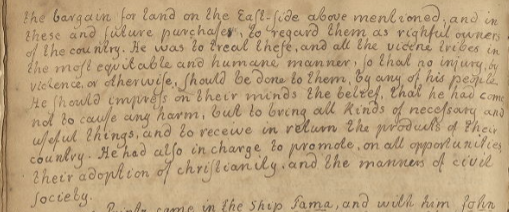
“Respecting the Indians The Governor was directed to confirm directly after his arrival, the treaty with the indians, by which they had stipulated the western shore of Delaware from the Cape Hinlopen to the Falls Sanhickans, and so much inland as gradually should be wanted; also to ratify the bargain for land on the east-side above mentioned; and in these and future purchaser, to regard them as rightful owners of the country. He was to treat these, and all the vicine tribes in the most equitable and humane manner, so that no injury, by violence or otherwise, should be done to them, by any of his people. He should impress on their minds the belief, that he had come not to cause any harm, but to bring all kinds of necessary and useful things, and to receive in return the products of their country. He had also in charge to promote on all opportunities their adoption of Christianity, and the manners of civil Society.”
After Prinze left, he appointed his son-in-law Pappegoia Vice Governor, who in turn left after two years, turning over the government of New Sweden to Reising, who took the title of General Director. Also image 17:

“Soon after his arrival he invited ten of the indian chiefs to a meeting. It was held at Tinicum the 17 of June 1654. He saluted them from the Swedish Queen with assurance of her favour put them in mind of the purchase of the lands already made and requested a continuation of their friendship. He distributed various presents among them, and gave a good entertainment to them and their company. They were well pleased, and assured him of a faithful affection.
Image 24 English, Image 21 Swedish – circa 1693:

We live also in peace, friendship and amity with one another, and the indians have not molested us for many years.
Image 47 – Additional Remarks by the Translator (Andrew Rudman, circa 1700):

“The conduct of the Swedes towards the indians was very prudent and friendly, by which they gained their good will and respect. Without this the first settlers being few might have been cut off and must even after being reinforced, have run great hazard. The instruction to governor Printz provided how carefully they should be treated. Being attached by kindness they were also awed by the military attitude of the Swedes. An example of this happened in 1645: They were discontented because the vessels carrying presents and good for traffic had not arrived, and their chiefs called a convention to resolve on war or peace. After a warm debate it was deemed best to continue in friendship, because the Swedes were good people and brave warriors.”
Image 156 English, Image 101 Swedish:

In the year 1715 The Indians on the borders of the Mississippi in South Carolina, of diverse tribes some thousand in number collected and killed hundreds of the Christians before they knew of it or could resist. At last one of these who notwithstanding, his being wounded, happily escaped and made their cruelties known to the inhabitants of Charleston. On this information all the inhabitants of the adjacent Country fled from their homes to Charleston but as that Town could not contain them, they took passage in the Trading vessels. Some went to Barbados others to New England and Philadelphia. This calamity was occasioned by some of the Traders that had dealt with the Indian tribes in a fraudulent manner. Those Indians however who lived here abouts have during the whole time of my ministry conducted themselves peaceable, so that we have always lived on friendly terms with them, and they on the other hand, have frequently renewed their treaty of alliance with our sovereign.
Indian Catechisms
I was curious to come across the following references to “Indian Catechisms.”
The page reproduced in image 28 is in Swedish, and the only English translation is the text imported by the book by Craig and Williams, referenced above.)
The blessed King showed us more than Royal Grace, called us into his chmbers, and asked us if we needed anything, and that if anyone had put obstacles in our way we should go immediately to Him and to no one else. We were delayed also because the Indians’ Catechisms’ were being printed and we had to wait for them.
The page reproduced in image 30 is likewise in Swedish with the newer translation accompanying:
And in like manner we receive too copies of the American (Indian) Catechism, which we received bound in brown leather with gilded edges and the King’s Coat of Arms gilded on both sides. And what is more we certify this with our signatures. Dated in Stockholm the 18th of July in the year 1696.
The “Additional Remarks by the Translator” (Rudman) in image 33 clarify:

The Indian catechism was composed by Campanius for the instruction of the Indians. It had not been printed in America, for want of convenience, and as the manuscript was for sufficient. It is the short catechism of Luther, in Swedish and Indian. The explication is, in proper cases adapted to thye manners of the Indians: for example daily bread is plentiful supply of venison and maize.
A copy of this catechism, held by the University of Pittsburgh, has been digitized by the Biodiversity Heritage Library, and can be viewed online here.
A selected illustration from the Indian Catechism:
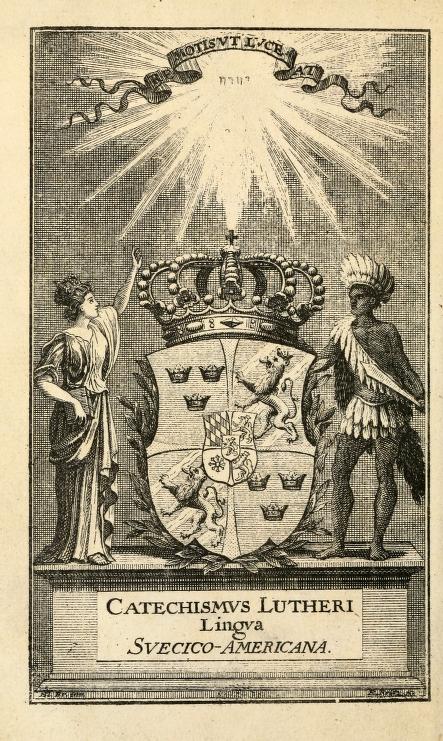
The cover of the above volume is a obviously a rebinding, however, a copy up for sale for $2196 at Bonhams may have the original leather cover, although the gilding of the coat of arms has disappeared since 1696.

Note from historian, archivist, curator and translator Kim Eric Williams: “Copies of the Indian Catechism are to be found at the American Swedish Historical Museum and in the Krauth Library of the United Lutheran Seminary, both in Philadelphia. A reprint is widely available and was printed in Stockholm in 1938.”
Symposium: “Digitizing the Records of Philadelphia’s Historic Congregations”
Christ Church organized a symposium to conclude the CLIR funded portion of this project. It was held on November 16, 2022 at the Athenaeum of Philadelphia, and we are pleased to offer the following recordings of the speakers, for those who could not attend.
1:30pm: Welcome, Overview of Project and Website
1:45PM: Paul Peucker, The Yellow Fever Pandemic of 1793 and the Moravians
2:15PM: Brandon Zimmerman, Resurrect Dead: Mount Vernon Cemetery and the Burial Ground of the Second Presbyterian Church of Philadelphia
3:00PM: Mike Krasulski, St. Paul’s and its Contributions to the Growth of Religion in Philadelphia
3:30PM: Kathryn Pyle, A Congregation’s Response to Its Racial History
4:15PM: Hidden stories from Transcribers:
Jean Craig, Pew Rent records and Social History
Elizabeth Mosier, Accidental Findings: Ephemera as Literary Inspiration
Josie Smith, Discovering Genealogies in the Philadelphia Yearly Meeting of the Religious Society of Friends Manumissions Records, 1772-1790
6:00PM: Keynote address: Julie Winch, Between the Lines and Across the Lines
David Dailey’s diaries: a circuit rider on the DelMarVa peninsula and his interactions with black parishioners
David Dailey was an itinerant preacher with the Methodist Church in the early 19th century, and he kept diaries of his travels on various “circuits” on the Delaware/Maryland/Virginia peninsula, which at the time was part of the Philadelphia Conference. These diaries have been preserved by St. George’s United Methodist Church and have been digitized as part of this project:
- Diary of preacher David Dailey, 1813-1814
- Diary of preacher David Dailey, 1814-1815
- Diary of preacher David Dailey, 1815-1816
- Diary of preacher David Dailey, 1816-1817
- Diary of preacher David Dailey, 1817
- Diary of preacher David Dailey, 1819-1820
Special thanks to Matthew Barger for transcribing these diaries, rendering them full-text searchable.
As with all colonial churches, the United Methodist Church has had a complicated relationship with race. Although its founding father, John Wesley, was vocal in his support of the abolition of slavery, racial segregation was official church policy until 1968.
Accordingly, Dailey routinely met with black classes separately from white classes during his travels, and a search on the transcribed text of these diaries using the terms “black,” “negro” and “coloured” turns up over 100 entries over the course of these eight years.
Dailey’s experiences on the road were often quite emotionally challenging, particularly early on, when he was often lonely and plagued with hoarseness. He recorded some of his difficulties with the black classes in his first diary:
Image 31, Friday August 20, 1813
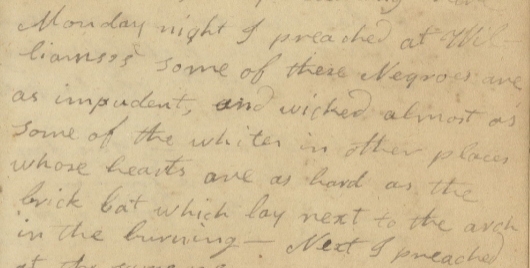
Monday night I preached at Williams’s some of these Negroes are as impudent, and wicked almost as some of the whites in other places whose hearts are as hard as the brick bat which lay next to the arch in the burning-.
Image 41, Thursday September 30, 1813
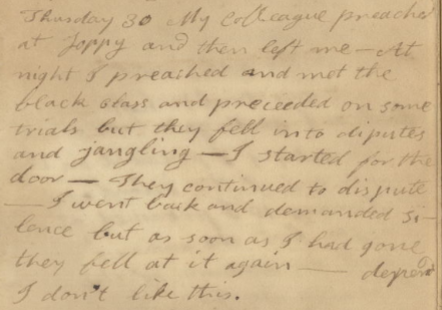
My colleague preached at [Joppy?] and then left me–At night I preached and met the black class and preceeded on some trials but they fell into disputes and jangling–I started for the door–They continued to dispute –I went back and demanded silence but as soon as I had gone they fell at it again–depress’d I don’t like this.
However, his experiences improve (with both black and white classes) in later diaries, where he wrote:
Sunday April 24, 1814

in the morning I met a large class of the most remarkable sensable black people that ever I saw, and felt happy among them.
Thursday, June 6, 1816
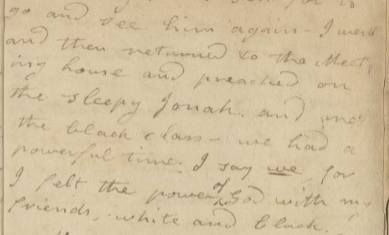
…after noon I went to brother Maddux’s–in the evening I was sent for to go and see him again–I went and then returned to the Meeting house and preached on the sleepy Jonah and met the black class–we had a powerful time. I say we for I felt the power of God with my friends, white and black.
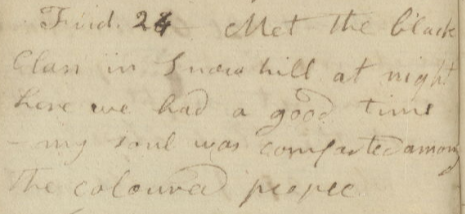
Met the black class in Snow hill at night here we had a good time –my soul was comforted among the coloured people.
There are far too many relevant entries to reproduce in one blog post, however, I have selected a few that might be of interest.
On Wednesday March 1, 1815 Dailey wrote:
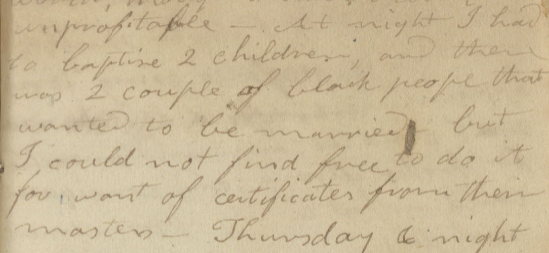
At night I had to baptise 2 children, and there was 2 couple of black people that wanted to be married–but I could not find free to do it for want of certificates from their masters.
Contrast this with Dailey’s entry from Saturday, January 8, 1820:
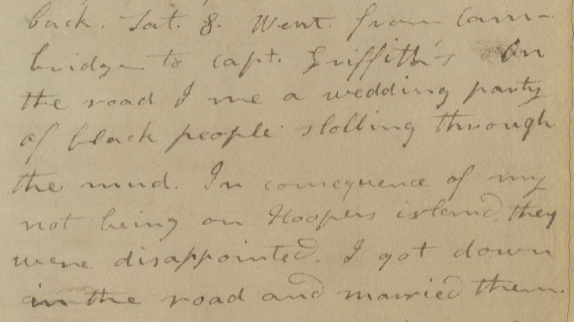
Went from Cambridge to capt. Griffith’s On the road I met a wedding party of black people slolling through the mud. In consequence of my not being on Hoopers island, they were disappointed. I got down in the road and married them.
Did the second group of betrothed carry some sort of proof of their freedom, or had Dailey come to regard the sacrament of marriage as one that should be granted freely regardless?
Other entries detail Dailey’s duties as a kind of judge, duties that he took seriously regardless of race.
Sunday, February 25, 1816
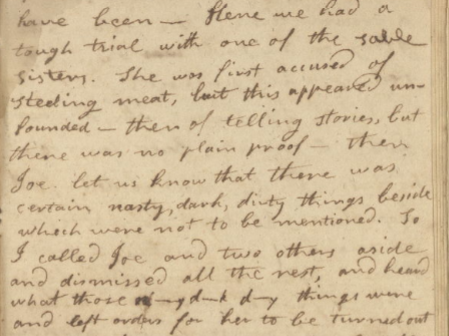
Here we had a tough trial with one of the sable sisters. She was first accused of steeling meat, but this appeared unfounded –then of telling stories, but there was no plain proof–then Joe let us know that there was certain nasty, dark, dirty things beside which were not to be mentioned. So I called Joe and two others aside and dismissed all the rest, and heard what those n-y d-k d-y things were and left orders for her to be turned out.
Dailey applied the same standards to the case of a black man three years later, in entries from Friday December 17, 1819 to Tuesday December 21, 1819
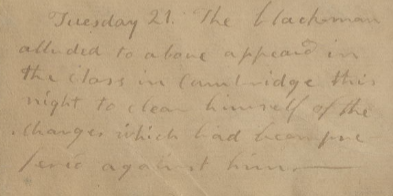
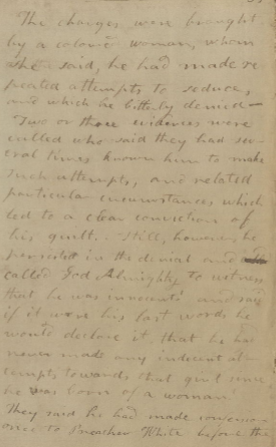
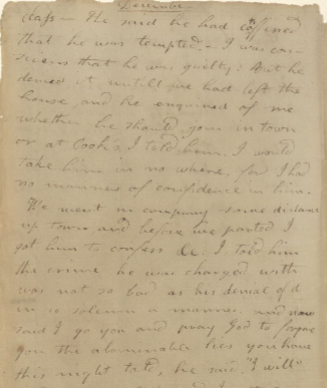
Tuesday 21. The black-man alluded to above appeared in the class in Cambridge this night to clear himself of the charges which had been [pre?ered] against him—- The charges were brought by a coloured woman, whom she said, he had made repeated attempts to seduce, and which he bitterly denied– Two or three evidences were called who said they had several times known him to make such attempts, and related particular circumstances which led to a clear conviction of his guilt…still, however, he persisted in the denial and called called God Almighty to witness that he was innocent! and said if it were his last word, he would declare it, that he had never made any indecent attempts towards that girl since he was born of a woman! They said he had made confession once to Preacher White before the class–He said he had confessed that he was tempted.–I was conscieus that he was guilty: But he denied it untill we had left the house, and he enquired of me whether he should join in town or at Cook’s I told him I would take him in no where, for I had no manner of confidence in him. We went in company some distance up town, and before we parted I got him to confess etc. I told him the crime he was charged with was not so bad as his denial of it in so solemn a manner. and now said I go you and pray God to forgive you the abominable lies you have this night told, he said “I will”
Three entries from the 1817 diaries also concern justice – or rather, racial injustice.
Tuesday May 13, 1817
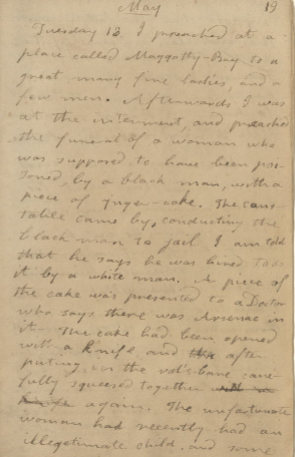
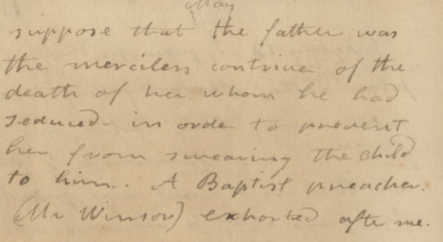
I preached at a place called Maggothy-Bay to a great many fine ladies, and a few men. Afterwards I was at the interment, and preached the funeral of a woman who was supposed to have been poisoned, by a black man, with a piece of ginger-cake. The canstable came by, conducting the black man to jail. I am told that he says he was hired to do it by a white man. A piece of the cake was presented to a Doctor who says there was Arsenac in it–The cake had been opened with a knife, and the after puting in the rat’s-bane carefully squeezed together with [?] knife again. The unfartunate woman had recently had an illegitimate child, and some suppose that the father was the merciless contriver of the death of her whom he had seduced–in order to prevent her from swearing the child to him.
Tuesday May 13/Wednesday May 14, 1817
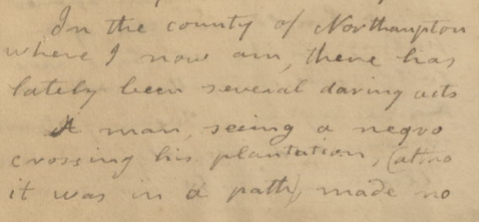
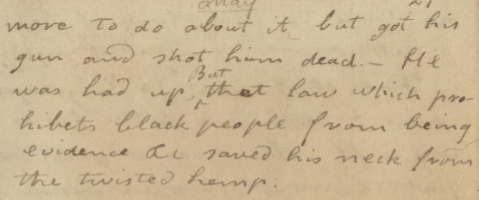
In the county of Northampton where I now am, there has lately been several daring acts A man, seeing a negro crossing his plantation, (altho it was in a path), made no more to do about it but got his gun and shot him dead.– He was had up But that law which prohibets black people from being evidence &c saved his neck from the twisted hemp.
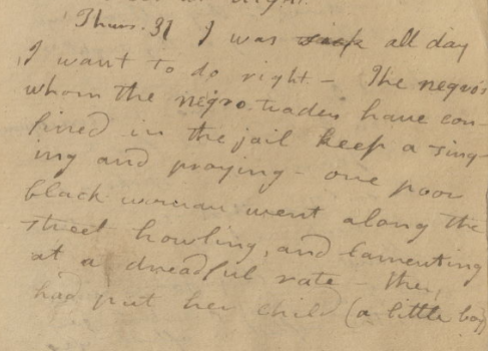

Thurs. 31 I was sick all day I want to do right.–The negro’s whom the negro traders have confined in the jail keep a-singing and praying–one poor black woman went along the street howling, and lamenting at a dreadful rate–then had put her child (a little boy) in jail to keep till they could send him to the south.
St. George’s has a list of all the relevant entries concerning black classes on Dailey’s various circuits – it might be interesting in the future for a researcher to map out the places on the Delmarva peninsula in which black classes regularly met.
Black families in the records of Christ Church, 1749-1825
Performing genealogical research on black families in America can be difficult. In addition to all the usual issues with older, handwritten records, black Americans weren’t even included by name in the U.S. Census until 1870.
Earlier this year, Archives Volunteer Extraordinaire Allan Hasbrouck performed an SQL query on our database of sacramental records, using the search terms “black,” “negro,” “slave,” “color,” and “coloured.” He found 506 baptisms and 209 marriages. However, by combing through the database and reviewing images of the records themselves, I was able to rule out some of those results as false hits on the name of Reverend Blackwell, and find several more relevant entries, in order to compile a list of 552 black baptisms and 235 black marriages.
In order to find all these entries, a computerized database search would have to include abbreviations such as ( C ), (c) or C, which could only be confirmed to denote “colored” by reviewing the records themselves. It would have to recognize that notations such as “of William Hopkins” or “of mary hog” denote a slaveholder/enslaved relationship. The additional term “mulatto” was spelled in eight different ways in the records, negro was misspelled as “negore” or “nogro,” slaves misspelled as “salves” or “slae.” Clearly, there is still a place for human eyes and brains in this kind of archival research!
Using these lists of black marriages and baptisms, I began to piece together a small number of black families, some enslaved and some not, who lived in colonial Philadelphia.
All the records for the 14 families below come from these five volumes, cited by volume number:
Vol. 29: Baptisms, marriages, and burials, Christ Church, 1719-1750
Vol. 30: Baptisms, marriages, and burials, Christ Church, 1750-1762
Vol. 31: Baptisms, Christ Church and St. Peter’s Church, 1763-1810
Vol. 32: Baptisms, Christ Church, St. Peter’s Church, and Saint James’s Church, 1811-1831
Vol. 36: Marriages, Christ Church and St. Peter’s Church, 1763-1836
Family 1
Quako and Hannah were married 2/2/1749. No last names are noted for bride or bridegroom, and both are recorded as “negroes slaves of Mr. Allen.” (Vol. 29, image 69.)
The records show Quako and Hannah had four children: Samuel, born 4/21/1749 and baptized 5/21/1749; Joseph, born 6/13/1751 and baptized 7/14/1751; James, born 10/29/1752 and baptized 12/3/1752; and Hanah, born 3/7/1755 and baptized 4/13/1755. (Volume 29, image 148 and Volume 30, images 5, 7, 9.)
Family 2
Emanual Woodbee and Jane Linkhorn, both noted as “free Negroes,” were married on 12/19/1756. (Vol 30, image 32.) The records show they had five children: Jane, born 2/20/1762 and baptized 3/27/1763; Joshua, born 6/16/1765 and baptized 8/21/1765; Abraham, born 7/26/1766 and baptized 8/24/1766; Elizabeth, born 7/17/1770 and baptized 9/2/1770; and Charlotte Hannah, born 8/16/1772 and baptized 8/16/1772. Note that the last name Woodbee is later spelled Woodby, several children are listed with no last name, and in one case only the father’s name is listed. (Vol 31, images 6, 21, 31, 71, 89.)
Family 3
William Keen and Cornelia Ray, both “free negroes,” were married on 10/3/1757. (Vol. 30, image 33.) According to our records, “Will & Cornelia, free negroes” had a daughter named Philip, born 1/22/1759 and baptized 3/4/1759. (It is possible the name was misspelled and should be Philis or Philippa.) Although no last name is listed for Philip, Cornelia is not a common name in the records and the dates fit. (Vol. 30, image 15.)
Family 4
Polydore and Rose were married on 12/31/1767. No last names listed; both noted as slaves. (Vol. 36, image 25.) They had a daughter named Sarah, born Sept. 1771, baptized 3/10/1772. (Vol. 31, image 86.)
Family 5
Fortune, “negro slave of Mr. Brown,” and Lucy, “negro slave of Mr. Philips” were married on 2/5/1771. (Vol. 36, image 38.) They appear to have had three children: George, born 3/31/1771 and baptized 5/1/1771; John, born 4/30/1778 and baptized 5/16/1779; and Ann, born 5/2/1783 and baptized 8/2/1783. (Vol. 31, images 77, 150, 196.)
Family 6
Thomas Frederick, “a free Negroe,” married Elizabeth, a slave, on 3/27/1782. (Vol. 36, image 71.) They had two children: John Francis Frederick, born 12/16/1782 and baptized 5/4/1783, and Catherine, born 1/13/1785 and baptized 8/7/1785. (Vol. 31, image 217.)
Family 7
Emanuel De Sylva married Judith Jones on 8/3/1783. They are noted as “Free Mulattos.” (Vol. 36, image 77.) It looks like Emanuel and Judith had a daughter named Mary Desylvas -such variations in spelling are common in the records- born 1/13/1785 and baptized 9/24/1786. (Vol 31, image 229,)
Family 8
John Williams married Hager (no last name listed) on 7/14/1784. Both are listed as “negroes.” (Vol. 36, image 80.) Their daughter, Rachel, was born in August of 1782, which is prior to their marriage date. However, Rachel was baptized on the same date as the marriage, which makes the familial relationship very likely. (Vol. 31, image 205.)
Family 9
Scipio married Elizabeth on 8/27/1784; no last names given, bride and groom listed as “blacks.” (Vol. 36, image 80). Peter Moore, son of Scipio and Betsy Moore (“negroes”), was born 8/31/1781 and baptized 9/23/1781. (Vol. 31, image 172.) Peter was born before the marriage of Scipio and Elizabeth, and Betsy is a variant of Elizabeth, but Scipio is a unique name in the records.
Family 10
William married Hannah on 12/1/1787. No last names given, bride and bridegroom noted as “negroes.” (Vol. 36, image 92). Elizabeth Scot, daughter of William and Hannah, “blacks”, was born 10/12/1792 and baptized 5/31/1793. (Volume 36, image 267) This match might be tenuous given the common first names and lack of last names in the marriage record. I talk more about such difficulties at the end of this blog entry.
Family 11
James Cole married Sarah Douglas (“blacks”), 5/16/1788. (Vol. 36, image 93.) They had a daughter named Sarah, born 7/1/1789 and baptized 7/26/1789. (Vol. 31, image 248.)
Family 12
Anthony Smith married Hannah Bean on 12/4/1788. (Vol. 36, image 94.) They had a son, Anthony, born 6/8/1791 and baptized 10/28/1791, and a daughter, Margaret, born 11/15/1795 and baptized 3/28/1796. (Vol. 31, images 259 and 285.)
Family 13
Peter B. Haines and Sarah Hickes were married on 10/23/1821. (Vol 36, image 239.) Stewart Douglas Haynes (again, such variations in spelling are common) was born to Sarah and Peter on 4/4/1825, and baptized on 4/14/1825. (Vol. 32, image 114)
Family 14
James Alsep married Sarah Stockton on 5/23/1822. (Vol 36, image 242.) The “(c)” marking, as seen in this record, serves as shorthand for “coloured” in these records, and is in fact expanded to “col” in their son’s record. Charles Alsop, son of James and Sarah, was born 6/2/1824 and baptized on 3/8/1825. (Vol 32, image 114.)
There are more possible family connections to be explored in these records, allowing for all the complications of handwritten records of the colonial era.
For example, Jacob and Easter married on 10/7/1770. No last names listed, “Jacob slave of Mr. Rogers, Easter slave of Mr. Casdrop.” (Vol 36, image 36.) A couple named Jacob and Esther, identified as “negroes,” had a daughter named Juliet, born 4/3/1771 and baptized 8/26/1771 (Vol. 31, image 81.) Is it possible the name Easter (or Esther) was written down incorrectly, and these are the same person – wife and mother?
Sometimes the names of bride and groom in a wedding record match the names of mother and father in a baptism record, but the child was born before the wedding. This could mean that there are two different couples, or that the couple married after having a child. Furthermore, if there are no last names listed and the first names are common, it is hard to determine relationships with accuracy.
Some more examples of difficulty discerning familial ties in these records:
Example 1) Hagar and William, “Negro slaves of Judge Laurence” were married on 9/7/1774. (Vol. 36, image 52.) William Maclain, born 9/22/1761 and baptized 11/18/1768, is listed as the “Natural Son of William Maclain & Hagar Jones, Molattoes.” (Vol 31, image 53.) “Natural” here means born out of wedlock, which would explain the discrepancy in dates; however, would a couple described as “molattoes” in one record then be described as “negro slaves” in another?
Example 2) Thomas, negroe slave of Paul Oxe, and Chloe, negroe slave of I. Solter, were married “by consent of their owners” on 12/31/1775. (Vol. 36, image 56.) A son named Thomas was born to John & Cloe “Nagroe Slaves of Mr. Cross” only seven months previously, on 5/1/1755 (Vol. 30, image 3.) Is it possible the bride and groom were sold by Mr. Cross to separate owners, after they had a child? Although heartbreaking, family separation was a common enough cruelty inflicted on enslaved people at that time.
Example 3) Sarah Fletcher and Isaac Richardson married as “Free negroes” on 10/13/1777. (Vol 36, image 61). Less than three years prior, twin sons named Samuel and Isaac were born to Isaac and Sarah, “negroe Slaves of James Tilghman, Esqr.” and baptized on 7/17/1774 at two months of age. (Volume 31, image 112.) It is possible there were simply two couples with the names Sarah and Isaac; it is also possible that Sarah Fletcher and Isaac Richardson started their family while enslaved, and were not able to marry until they were later freed.
Example 4) Phillis and John, slaves of Edward Milne and Jonas Phillips, were married on 8/25/1779. (Vol. 36, image 65.) No last names were listed. The previous year, a daughter named Frances was born to John and Phillis Williams, “negroes.” (Vol. 31, image 148). (Frances was baptized 3/21/1779). Was she born to a different John and Phillis, or was she what was then called a “natural child,” although not noted as such?
Clearly, this kind of research can be very complicated and messy. However, with these records online and available to the public, the tracing of black American families in colonial Philadelphia has become a more promising endeavor.
Two emergency burials?
by Jean Craig
In the course of transcribing lists of names and dates to expand their usefulness locally and throughout the world of research, aspects recorded in otherwise repetitive information wakes up curiosity, and these details evoke yet other questions.
From volume 4 of the Burial Records of the Second Presbyterian Church, p. 48: February 20th, 1819 records the burial of “a child of a stranger at the furlgate in the Old York Road.” Wikipedia says that the Old York Road was built in the 18th century to connect Philadelphia and New York City. Its beginning (or one end) was at 4th and Vine, not far from Second Presbyterian Church, or from a fair number of other Philadelphia churches. What was the connection to this church?
What was a furlgate? The Internet pointed to the English word falgate, derived from the Middle English “fold gate”; this was an entryway to an enclosure, possibly for cattle or sheep. Were the people drovers who made the request for burial? The word came to mean an inn-yard. Various inns of England have the name Falgate; were the people in Pennsylvania traveling by the Swift Sure Stage Coach Line which covered the York Road route and perhaps had stopped somewhere still known as the falgate to deal with a four-year old child in distress?
The time of year would have meant penetrating cold and precipitation. Were the travelers near enough to Philadelphia to hope they’d arrive soon enough to get help for the child? Whoever sought burial for the child had to come up with $8 for the cost of interment.
…
From Vol.6, p. 8 of the same church’s Burial Records for 1837-1850: Burial entry 590 for October 28, 1845, records the death of Susan Jackson Bancroft, daughter of the Secretary of the Navy. He was George Bancroft, a wonderfully energetic and broad-minded man who took full advantage of every opportunity given him for education and making a social contribution. He was appointed Secretary to the Navy by President James K. Polk. His appointment was political, and his time in office was brief, but long enough for him to establish the U.S. Naval Academy at Annapolis to provide structured learning for midshipmen awaiting assignment to ships. Little Susan was 6 years old, from Bancroft’s second marriage to a Bostonian, Elizabeth Davis Bliss; Susan’s middle name was for Andrew Jackson; her father was a staunch Democrat.
By this time, but before the coming of medical examiners, churches were recording causes of death where possible. The church record states that Susan Bancroft died of “marasmus,” usually interpreted as starvation, this unbelievable given the Bancrofts’ prosperity and sophistication. Susan may have been a fragile child, and her cause of death “failure to thrive” because of her body’s inability to assimilate certain proteins. Again, why this church? Bancroft then worked in Washington, D.C. Was the couple or family traveling or visiting here when their child descended into her final illness? Her remains were placed in the vault of the Leiper family, in the Arch St. burial ground, for no charge. In vol. 6 p. 14 [addenda], ten years later, on Oct. 22, 1856, during the great migration to what were then roomier suburban cemeteries outside of city limits, Order no. 708 requests the removal of her remains from that vault, to go to South Laurel Hill Cemetery, but her name is not on the records there. The Bancrofts were New Englanders. George was born and buried in Worcester, Mass. Might she have been taken there?
Call for Proposals: A Symposium on the Digitized Records of Philadelphia’s Historic Congregations
Date: November 2, 2022
Hybrid conference, virtual and in-person at the Athenaeum of Philadelphia
After five years of digitizing and harvesting the records of Philadelphia’s historic congregations, we have more than 80,000 scanned documents reflecting faith traditions, family celebrations and liturgical changes as well as political and social issues of the 18th and early to mid 19th century. The project brings these records together with transcriptions, lesson plans, a digital map, and recordings of talks given over the course of the project.
To celebrate the project’s conclusion we invite scholars, genealogists, teachers and all those interested to share their experiences in using religious records and what they’ve learned from them. Our focus is on the time period the project covers, 1680-1871, and may include topics such as biography, genealogy, reconciliation projects, and archival methodology. Talks can take the form of single papers or panel discussions.
Our keynote speaker is Julie P. Winch, Ph.D., Professor of History from the University of Massachusetts, Boston, who specializes in the history of African Americans, the Early Republic, maritime history and online research. Dr. Winch has written a number of books in these fields, including Between Slavery and Freedom: Free People of Color in America from Settlement to the Civil War (Rowman & Littlefield, 2014).
To submit a proposal, please include a 250-word abstract with the resumes of your speakers, and send it to Carol Smith, Archivist for Christ Church and the Christ Church Preservation Trust, at csmith@christchurchphila.org.
Deadline for submissions: August 15, 2022
Notification of acceptance: September 1, 2022
Contact for questions: Carol Smith, Archivist, Christ Church and Christ Church Preservation Trust and one of the project’s primary investigators. csmith@christchurchphila.org
About the project: “Digitizing the Records of Philadelphia’s Historic Congregations: Providing Documentation for the Political, Social and Cultural Developments in Philadelphia,” is a multi-year initiative supported by the Council on Library and Information Resources and funded by the Andrew W. Mellon Foundation, with supplemental funding by the Pennsylvania Historical and Museum Commission and the Connelly Foundation. It has brought together the records of 17 different congregations established in Philadelphia in the 18th century. Those manuscript materials include minutes, sacramental registers, sermons, correspondence, accounting records and more. The site can be viewed at www.philadelphiacongregations.org.
Shape-note music
Contributed by Jean Craig
When we choose a new set of documents or a ledger to transcribe, interesting material can appear in the pages outside of the formal texts or lists. Sometimes there are sketches, short jottings, loose material inserted, or other writings that the contemporary person did not want to let slip away. Our mandate is to try and describe these addenda as carefully as we can, as what we supply may add important social or historical context and be of help to a researcher. And, sometimes, these addenda prove intriguing and fun.
One such find — historical, cultural, and intriguing — was on an endpaper at the close of the first volume of Burial Records for the Second Presbyterian Church, with records dating from 1785 to 1808. On a page with a final few entries and other jottings, I saw what appeared to be a design of some sort running down the outside edge of the paper. Upon rotating the image, the “design” proved to be a hymn written on an extended staff as shape-note music.
Running down the right margin of this page [76]: the word Condolance [sic] written at the very edge of the page; below it is a hymn written as shape-note music; the first verse is written below the staff and reads:
Kind is the speech of Christ our Lord.
Affection sounds in every word
Lo thou art fair my love he cries
Not the young doves have sweeter eyes
Shape note music was a notation created in England in the late 18th century to allow people with little to no musical training to sing in churches or at social gatherings. The different shapes helped in finding pitches in major or minor scales, and became very popular in early America, especially in rural areas. Contemporaries sometimes called the shaped notes “dunce” notes, but they were easy to learn and made people without access to music lessons or money for musical instruments able to participate in singing. In this case, one of the church officials, perhaps the sexton or one of his helpers, appreciated this hymn enough to set it down and have it available, and shape notes allowed that to happen.
An internet search of the first line of this hymn went to Hymnary.org, which gives the title of the hymn as The Completeness of Christ, and its author as Rev. Isaac Watts (1674-1748). Hymnary.org also includes a chart showing the popularity of the hymn over time, and refers to a set of volumes Watts published around 1707, entitled Hymns and Spiritual Songs, a later edition of which has been published online by Project Gutenberg. In this edition, the title of the song is given as “The church’s beauty in the eyes of Christ.”
Second Presbyterian’s Session Minutes, vol. 1, 1744-1798, pp. 40-42, mention Watts’ paraphrases of the Psalms, because they caused a commotion when they were suddenly introduced to the congregation in that year. This was not because the music was inferior, but because conservative members wanted what they were used to, and had not been given enough notice of the change, even a change that had been OK’d by the Synod. The church held a special meeting of the congregation with a vote to settle the matter; Watt’s work won the day. The conservatives in the congregation wanted to mount an appeal to the Session, which was granted, but the Session notes don’t record any further action. Rev. Watts’s hymns were enormously popular in the 18th century and beyond. Congregations still sing some of them nowadays.
